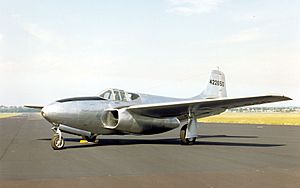Ann Baumgartner facts for kids
Quick facts for kids
Ann Baumgartner
|
|
|---|---|
| Born | August 27, 1918 |
| Died | March 20, 2008 (aged 89) |
| Allegiance | United States of America |
| Service/ |
United States Army Air Forces |
| Unit | Women Airforce Service Pilots |
Ann G. Baumgartner Carl (born August 27, 1918 – died March 20, 2008) was an amazing American aviator. She made history by becoming the first American woman to fly a United States Army Air Forces jet aircraft. This happened when she flew the Bell YP-59A jet fighter at Wright Field. She was a test pilot during World War II. Ann was part of the Women Airforce Service Pilots (WASP) program. She worked at Wright Field as an assistant operations officer in the fighter test section.
Contents
Ann's Early Life
Ann G. Baumgartner was born on August 27, 1918, in a U.S. Army Hospital in Augusta, Georgia. Her father was in France at the time. So, her mother moved the family to New Jersey to live with Ann's grandparents. After her father came back to the United States, they moved to Plainfield, New Jersey. Her dad was an engineer and a patent attorney.
Ann was inspired to fly after Amelia Earhart visited her school. She also loved going to Newark Airport with her father. They would watch the mail planes land at night.
Ann graduated from Walnut Hill High School in Natick, Massachusetts. Then, she went to Smith College in Northampton, Massachusetts. She finished college in 1940, studying to become a doctor.
While working for Eastern Airlines in their public relations department, Ann learned to fly. She took lessons at Somerset Hills Airport in Basking Ridge, New Jersey.
Flying with the WASP Program
Ann Baumgartner first went to Houston, Texas, in January 1943. She was supposed to join the Women Airforce Service Pilots (WASP) Class of 43-W-3. But she got sick with the measles. So, she graduated later, on July 3, 1943, with the fifth WASP class (43-W-5).
After her training, Ann was sent to Camp Davis in North Carolina. There, she worked as a tow target pilot. Camp Davis was a base where soldiers practiced artillery. The WASPs would fly planes as targets for visual and radar tracking. At Camp Davis, Ann flew many different planes. These included the Douglas A-24, Curtiss A-25, Lockheed B-34, Cessna UC-78, and Stinson L-5.
In February 1944, Ann moved to Wright Field near Dayton, Ohio. This was a temporary job to test medical equipment for the WASP program. While in Ohio, Ann asked for a job in the Flight Test Division at Wright Field. She wanted to be an assistant operations officer. In March 1944, she was transferred there. She worked in the fighter test section.
Ann Becomes a Test Pilot
At first, Ann's duties were mostly office work. But over time, she was allowed to fly as a test pilot. She also transported staff officers to other Army bases. And she delivered planes when needed. Ann worked for a short time in the bomber flight test division. There, she gained experience as a pilot and copilot. She flew planes like the B-17, B-24, B-29, the British de Havilland Mosquito, and the German Junkers Ju 88.
After returning to the fighter test division, she flew America's first jet aircraft. This was the Bell YP-59A. She flew it on October 14, 1944. This made her the first American woman to fly a jet! Her job as a fighter flight test pilot at Wright Field ended in December 1944. This was when the WASP program was officially ended.
Marriage and Family
Ann Baumgartner married Major William Carl on May 2, 1945. She met Carl while flight testing a plane he designed. It was the Twin Mustang P-82. Carl continued his career as an engineer. Later, he designed and built special boats called hydrofoil boats. These were for the United States Navy and Grumman Aerospace.
Ann and William had two children together. With her husband, Ann sailed across the Atlantic Ocean twice. They also cruised in the Mediterranean Sea, around the British Isles, and through the French Canals.
Ann's Later Career
When her children were young, Ann worked in flight instruction. She also worked for United Airlines and as a third pilot at Zahn's Airport on Long Island. She had many flight ratings. These included private, commercial, instrument, multi-engine, flight instruction, and instrument ratings. Later, she became a journalist who wrote about science.
Later Life and Death
In her final years, Ann Baumgartner Carl lived in Kilmarnock, Virginia, with her husband. She kept writing books. She wrote A WASP among Eagles: a woman military test pilot in World War II. This book was about her experiences as a test pilot in World War II. She also wrote "The Small World of Long Distance Sailors."
Ann Carl passed away at a nursing home in Kilmarnock on March 20, 2008. Her husband had passed away just before her, on February 19, 2008.
See Also


